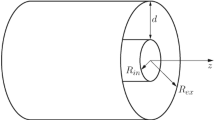Summary
The stability of an incompressible, viscous and electrically conducting fluid cylinder in the presence of an axial current is investigated. The effect of surface tension is taken into account while the effect of gravity is neglected. It is shown that the inclusion of viscous effects reduces the growth rate of instabilities. In the case of mercury the amount of reduction in the growth rates is negligibly small.
Similar content being viewed by others
References
Chandersekhar, S., Hydrodynamic and Hydromagnetic Stability, p. 541, Clarendon Press, Oxford 1961.
Taylor, R. J., Proc. Phys. Soc.B 70 (1957) 31.
Murty, G. S., Arkiv Fysik18 (1960) 241.
Morse, P. M. and H. Feshbach, Methods of Theoretical Physics, Part I, p. 529, McGraw Hill, New York, 1953.
Sokolnikoff, I. S., Mathematical Theory of Elasticity.
Lamb, H., “Hydrodynamics”, p. 472, Dover Publications 1945.
Author information
Authors and Affiliations
Rights and permissions
About this article
Cite this article
Banghar, A.R. Instability of a viscous, incompressible and electrically conducting fluid cylinder due to axial current. Appl. Sci. Res. 12, 277–288 (1965). https://doi.org/10.1007/BF00382127
Received:
Issue Date:
DOI: https://doi.org/10.1007/BF00382127




